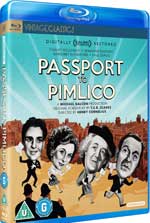
Director: T.E.B. Clarke
Running Time: 81 mins
Certificate: U
Release Date: June 11th, 2012

Passport To Pimlico is an unexpectedly important movie in British film history, as along with Kind Hearts & Coronets and Whisky Galore – all of which were released by Ealing in 1949 – they set the template for much of the UK’s comedy output right up to the present day. In the film you can see early whispers of Carry On (not least the presence of Charles Hawtrey in a small role), a wink at the absurd that was later taken to its limit by the likes of Monty Python, and a quintessentially British attitude that’s still evident today, not least in the light, heartfelt comedy of Richard Curtis.
It’s a timeless film that is very time specific, as while it’s absolutely rooted in a very particular period just after the Second World War, it’s about ideas and a belief in the little guy that’s as easy to get behind today as it was when the film was made. In a small part of London’s Pimlico, an unexploded WWII bomb is accidentally detonated, uncovering a treasure trove of riches and a document which reveals that centuries ago, the area became part of Burgundy, and is therefore foreign territory.
At first this seems like a boon to the locals, as the fact they’re all now foreigners means they don’t have to abide by the privations of late 40s life, such as rationing. However the British Government soon begins to realise this, decides to set up border controls and eventually begins a blockade of the area. The Burgundians (which the residents come to be known as) don’t want to give up their newfound nation without a fair deal, but can they find a way to outlast the bullying authorities?
With a sweet story that has faith in a shared humanity, great performances by wonderful actors like Stanley Holloway, Hermione Baddeley and Margaret Rutherford, and a very witty script, Passport To Pimlico is a wonderful movie. Perhaps most interesting is that as well as being a funny, well written and paced film, it’s also a window into a very particular moment in British history (although as mentioned looking at it in timeless ways).
This is a world that’s still reeling from war, where residents live amongst bombed out houses and craters, where finding unexploded bombs is seen as unremarkable, and where everything people can and can’t buy is dictated by ration books. Although the little guy wanting to take control back from overbearing authority is a universal theme, in Passport To Pimlico you can really feel the frustration of the population. These are people who spent years willingly going without because they were told it would help win the war, and now several years after peace was declared, they’re still having to put up with major privations. They want a sense of victory and for normality to return to everyday life.
There’s also the major influence of the Berlin blockade, which was going on when Passport To Pimlico was being made and obviously inspired much of the movie. For around a year, the Soviet Union blocked road, railway and canal access to the parts of Berlin under allied control, in order to try take to control of the city (at least economically). In response the allies organised an airlift, which brought in over 200,000 planeloads of supplies to ensure those in the non-Soviet parts of Berlin didn’t come under communist control. It was actually a tad daring for Passport To Pimlico to equate the British Government’s authoritarian attitude with that of Soviet Russia, but it did it with such charm and belief in people power that it got away with it and was a major hit.
This newly restored version hits Blu-ray with a picture that’s been expertly cleaned to remove major blemishes and scratches that have built up over the years. There’s still a fair amount of grain, but that’s how it should be, as the black & white picture looks as it should, without the over-processed, slightly artificial cleanliness that happens when old movie are restored too harshly.
There are also a few decent extras, with Ealing expert Mark Duguid talking about where Passport To Pimlico sits in the British comedy pantheon and Richard Dacre taking us onto the London streets to show us where the film was made – which is now nondescript post-war residential blocks, but in 1948 an expertly constructed set. There’s also a before and after comparison showing the restoration of the film and a stills gallery.
Overall Verdict: A great film that’s still funny, sweet and charming, taking on timeless themes while giving us a sharp look at life just after World War II.
Reviewer: Tim Isaac





Leave a Reply (if comment does not appear immediately, it may have been held for moderation)